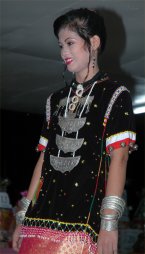Bisaya (Borneo)

Sarawakian Bisaya traditional costume.
|
|
| Regions with significant populations | |
|---|---|
|
Sarawak: 7,000 (1984) Sabah: 22,000 |
|
| Languages | |
| Sabah Bisaya language, Malaysian, Bisaya, English | |
| Religion | |
| Majority Islam and significant minorities of Christianity and Animism | |
| Related ethnic groups | |
| Murut, Kadazan-Dusun, Dayaks |
The Bisaya are an indigenous people of the north-west and the coast line of Borneo, Malaysia. They mostly live near the Beaufort district, the Padas River also Kuala Penyu in the Sabah region. There are also some Bisaya living in Kampung Manunggang, Sabah, which follow no religion and along the Limbang River in the northern state Sarawak. Nowadays the Bisaya living in Sabah are mostly Muslim, with a smaller Christian community, while the Bisaya living in Sarawak are mostly Christian, with a smaller Muslim community. The Bisaya people are also regarded as a sub-ethnic of the Dayak people.
Several theories have been put forward by various researchers regarding the origins of the name of the Bisaya people. Beyer H.O. in 1926, Hester E.D. in 1954 and Harrison in 1956 suggested that the name may have come from the empire of Sri Vijaya (Sonza, 1972). However, in 1960, Eugene Vestraelen (Professor of Linguistics at the University of San Carlos, Cebu City) cautioned that the linguistic derivation of Vijaya would not be Bisaya but Bidaya, or Biraya.
In 1960, John Carol suggested that the name originated from a cultural hero named Sri Visaya.
Another theory is that the word Visaya (or Bisaya, as it is pronounced in the Philippines) comes from the word for the Hindu merchant, trader, herder, artisan, landowner (etc.) caste: the "Vaishyas", which can be traced back to Sanskrit, and assume that the label was given by the Sri Vijayans and others pirates and traders coming from India.
Bisaya's indigenous people settled in Borneo thousands of years ago. The Bisaya were a people who were loved, feared and respected by others on this island. They are skilled in agriculture, particularly in the areas such as paddy planting, ginger, sago, local ginger, tapioca, banana, yam, pepper, coconut. They also hunt animals and breed others, such as chicken, duck, goose, goat, buffalo, cows and many more.
...
Wikipedia
